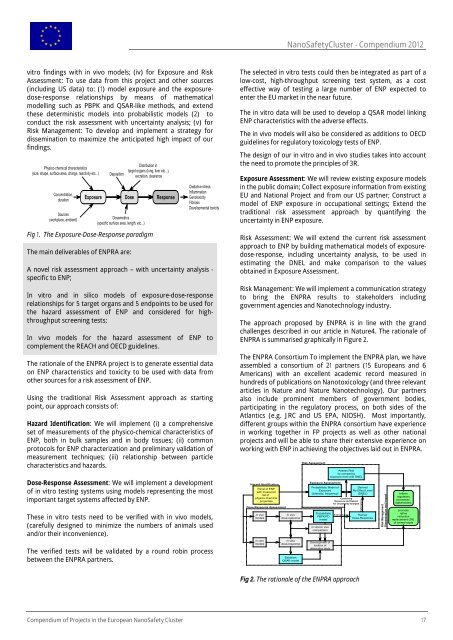Timing, hosts and locations of (grouped) events of NanoImpactNet
Timing, hosts and locations of (grouped) events of NanoImpactNet
Timing, hosts and locations of (grouped) events of NanoImpactNet
Create successful ePaper yourself
Turn your PDF publications into a flip-book with our unique Google optimized e-Paper software.
vitro findings with in vivo models; (iv) for Exposure <strong>and</strong> Risk<br />
Assessment: To use data from this project <strong>and</strong> other sources<br />
(including US data) to: (1) model exposure <strong>and</strong> the exposuredose-response<br />
relationships by means <strong>of</strong> mathematical<br />
modelling such as PBPK <strong>and</strong> QSAR-like methods, <strong>and</strong> extend<br />
these deterministic models into probabilistic models (2) to<br />
conduct the risk assessment with uncertainty analysis; (v) for<br />
Risk Management: To develop <strong>and</strong> implement a strategy for<br />
dissemination to maximize the anticipated high impact <strong>of</strong> our<br />
findings.<br />
Physico-chemical characteristics<br />
(size, shape, surface area, charge, reactivity etc...)<br />
Concentration,<br />
duration<br />
Sources<br />
(workplace, ambient)<br />
Exposure<br />
Deposition<br />
Dosemetrics<br />
(specific surface area, length, etc...)<br />
Distribution in<br />
target organs (lung, liver etc...),<br />
excretion, clearance<br />
Dose Response<br />
Fig 1. The Exposure-Dose-Response paradigm<br />
The main deliverables <strong>of</strong> ENPRA are:<br />
Oxidative stress<br />
Inflammation<br />
Genotoxicity<br />
Fibrosis<br />
Developmental toxicity<br />
A novel risk assessment approach – with uncertainty analysis -<br />
specific to ENP;<br />
In vitro <strong>and</strong> in silico models <strong>of</strong> exposure-dose-response<br />
relationships for 5 target organs <strong>and</strong> 5 endpoints to be used for<br />
the hazard assessment <strong>of</strong> ENP <strong>and</strong> considered for highthroughput<br />
screening tests;<br />
In vivo models for the hazard assessment <strong>of</strong> ENP to<br />
complement the REACH <strong>and</strong> OECD guidelines.<br />
The rationale <strong>of</strong> the ENPRA project is to generate essential data<br />
on ENP characteristics <strong>and</strong> toxicity to be used with data from<br />
other sources for a risk assessment <strong>of</strong> ENP.<br />
Using the traditional Risk Assessment approach as starting<br />
point, our approach consists <strong>of</strong>:<br />
Hazard Identification: We will implement (i) a comprehensive<br />
set <strong>of</strong> measurements <strong>of</strong> the physico-chemical characteristics <strong>of</strong><br />
ENP, both in bulk samples <strong>and</strong> in body tissues; (ii) common<br />
protocols for ENP characterization <strong>and</strong> preliminary validation <strong>of</strong><br />
measurement techniques; (iii) relationship between particle<br />
characteristics <strong>and</strong> hazards.<br />
Dose-Response Assessment: We will implement a development<br />
<strong>of</strong> in vitro testing systems using models representing the most<br />
important target systems affected by ENP.<br />
These in vitro tests need to be verified with in vivo models,<br />
(carefully designed to minimize the numbers <strong>of</strong> animals used<br />
<strong>and</strong>/or their inconvenience).<br />
The verified tests will be validated by a round robin process<br />
between the ENPRA partners.<br />
NanoSafetyCluster - Compendium 2012<br />
The selected in vitro tests could then be integrated as part <strong>of</strong> a<br />
low-cost, high-throughput screening test system, as a cost<br />
effective way <strong>of</strong> testing a large number <strong>of</strong> ENP expected to<br />
enter the EU market in the near future.<br />
The in vitro data will be used to develop a QSAR model linking<br />
ENP characteristics with the adverse effects.<br />
The in vivo models will also be considered as additions to OECD<br />
guidelines for regulatory toxicology tests <strong>of</strong> ENP.<br />
The design <strong>of</strong> our in vitro <strong>and</strong> in vivo studies takes into account<br />
the need to promote the principles <strong>of</strong> 3R.<br />
Exposure Assessment: We will review existing exposure models<br />
in the public domain; Collect exposure information from existing<br />
EU <strong>and</strong> National Project <strong>and</strong> from our US partner; Construct a<br />
model <strong>of</strong> ENP exposure in occupational settings; Extend the<br />
traditional risk assessment approach by quantifying the<br />
uncertainty in ENP exposure.<br />
Risk Assessment: We will extend the current risk assessment<br />
approach to ENP by building mathematical models <strong>of</strong> exposuredose-response,<br />
including uncertainty analysis, to be used in<br />
estimating the DNEL <strong>and</strong> make comparison to the values<br />
obtained in Exposure Assessment.<br />
Risk Management: We will implement a communication strategy<br />
to bring the ENPRA results to stakeholders including<br />
government agencies <strong>and</strong> Nanotechnology industry.<br />
The approach proposed by ENPRA is in line with the gr<strong>and</strong><br />
challenges described in our article in Nature4. The rationale <strong>of</strong><br />
ENPRA is summarised graphically in Figure 2.<br />
The ENPRA Consortium To implement the ENPRA plan, we have<br />
assembled a consortium <strong>of</strong> 21 partners (15 Europeans <strong>and</strong> 6<br />
Americans) with an excellent academic record measured in<br />
hundreds <strong>of</strong> publications on Nanotoxicology (<strong>and</strong> three relevant<br />
articles in Nature <strong>and</strong> Nature Nanotechnology). Our partners<br />
also include prominent members <strong>of</strong> government bodies,<br />
participating in the regulatory process, on both sides <strong>of</strong> the<br />
Atlantics (e.g. JRC <strong>and</strong> US EPA, NIOSH). Most importantly,<br />
different groups within the ENPRA consortium have experience<br />
in working together in FP projects as well as other national<br />
projects <strong>and</strong> will be able to share their extensive experience on<br />
working with ENP in achieving the objectives laid out in ENPRA.<br />
Hazard Identification<br />
Panel <strong>of</strong> ENP<br />
with measured<br />
list <strong>of</strong><br />
physico-chemical<br />
properties<br />
Dose-Response Assessment<br />
in vivo<br />
dose-response<br />
Risk Assessment<br />
Assess Risk<br />
by comparing<br />
exposure level with DNEL<br />
Compendium <strong>of</strong> Projects in the European NanoSafety Cluster 17<br />
in vivo<br />
models<br />
in vitro<br />
models<br />
in vitro<br />
dose-response<br />
Establish<br />
QSAR model<br />
Exposure Assessment<br />
Probabilistic Model <strong>of</strong><br />
Derived<br />
Exposure<br />
No Effect Level<br />
(Intensity, frequency)<br />
(DNEL)<br />
Combining<br />
Exposure <strong>and</strong> Hazard<br />
for Uncertainty Analysis<br />
Probabilistic<br />
PBPK/PD<br />
model<br />
in vitro/in vivo<br />
comparison<br />
Development <strong>of</strong><br />
toolbox <strong>of</strong><br />
alternative tests<br />
Extrapolation<br />
Fig 2. The rationale <strong>of</strong> the ENPRA approach<br />
Estimation<br />
Human<br />
Dose-Response<br />
Risk Management<br />
Dissemination <strong>and</strong> Impact<br />
Inform<br />
regulatory<br />
processes,<br />
stakeholders<br />
promote<br />
refine<br />
reduction<br />
replacement (3R)<br />
<strong>of</strong> animal expts






